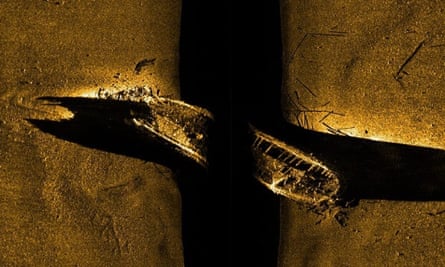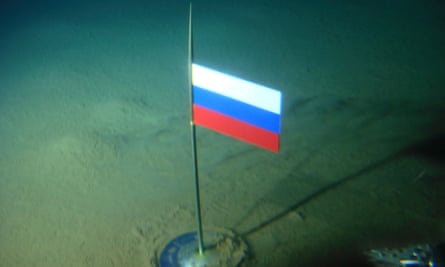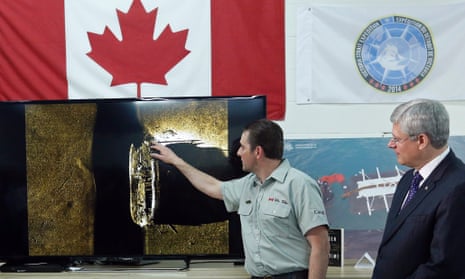For several centuries, the North-West passage was a myth. The idea of a route around the frozen north of Canada to the Indies that avoided the French, Dutch and Spanish ships that prowled the south seas was a fabulous prize for the British, one that spawned hundreds of expeditions, beginning as early as the reign of Henry VII.
By 1815, war with Napoleon was over and the British had a gigantic navy with nothing to do. For John Barrow, the secretary of the Admiralty, finding the passage was an obsession, says Michael Smith, author of Last Man Standing, a biography of Francis Crozier, the captain of the HMS Terror. He sent a flurry of expeditions. As Smith says: “All spectacularly failed.”
The Franklin expedition, in 1845, was Barrow’s last shot. It was commanded by Rear Admiral Sir John Franklin, a retired diplomat and explorer who had never actually attempted a polar expedition by sea before. The HMS Terror and the HMS Erebus, state-of-the-art steamships with iron-reinforced hulls, set sail from England on 19 May, accompanied by a supply vessel, the Baretto Junior, which was to go as far as Greenland.
The Guardian – at the time still the Manchester Guardian – printed a letter sent back to England with the Baretto Junior by one of the officers of the expedition, written by the light of the midnight sun. “The weather here is delightful,” it reads. “We have received accounts from the Danes that the state of the ice to the northward is very favourable to our enterprise.”
“Who knows!” it goes on. “We may get through this year.”
The two ships were reported seen by British whaling ships in Baffin Bay, west of Greenland, before they left to cross Lancaster Sound. They were never seen again.

Exactly what happened to the Franklin expedition was a mystery that captured the public imagination. Dozens of missions to find the ships were launched, and while they never found them, during the search the northern waterways of Canada were mapped and explored.
John Rae, a Scottish explorer and a consultant for the Hudson Bay Company, contacted native Inuit who had found the remains of some of the members of the doomed expedition. He concluded that “it is evident that our wretched Countrymen had been driven to the last dread alternative – cannibalism”.
To prove his case, he brought back some artefacts the Inuit had. One of them was a silver plate engraved with the name of Sir John Franklin.
Apart from these findings, the fate of the expedition remained a mystery for almost 170 years – until this week, when the wreckage of one of the ships was found by a Canadian scientific team. Ryan Harris, one of the lead archaeologists on the expedition, said that finding the ship was “like winning the Stanley Cup”.
The official announcement of the find was made by Stephen Harper, the prime minister of Canada.
“This is truly a historic moment for Canada,” he said, in a bombastic statement to the press. “Franklin’s ships are an important part of Canadian history given that his expeditions, which took place nearly 200 years ago, laid the foundations of Canada’s Arctic sovereignty.”
The certainty of the statement was perplexing to Suzanne Lalonde, a professor of international law at the University of Montreal. “I’ve been struggling with it – the way Prime Minister Harper announced the find as if there was a monumental confirmation of Canadian sovereignty,” she told the Guardian.
Canada’s position is that the North-West Passage is already Canadian. In an official statement to the Guardian, Christine Constantin, a spokeswoman for the Canadian embassy in Washington, said: “All waters of the Canadian Arctic archipelago, including the various waterways known as the ‘North-West Passage’, are internal waters of Canada … Canada’s sovereignty over its waters in the Arctic is longstanding and well established.
“No one disputes that the various waterways known as the ‘North-West Passage’ are Canadian waters.”
The routes usually taken to constitute the North-West Passage pass between Canada’s mainland territory and its Arctic islands.

Unfortunately, the United States disputes just that. A State Department official told the Guardian there has been “no recent change in our position – the North-West Passage is an international strait”.
This might come as news to most Canadians. “If you asked the average Canadian,” says Tim Harper, a columnist for the Toronto Star (and no relation to the PM), “they would have no idea there was dispute. We believe that is our territory.”
Harper thinks that the prime minister’s statement is a conscious move by the Canadian government, aimed at establishing Canada’s de facto sovereignty over the North-West Passage in the collective psyche.
“The way [Stephen Harper] made Arctic sovereignty a priority when he came to power – he is trying to counteract the US view that this is an international waterway,” he said. “The more activity, the more high-profile actions – which this certainly was – it makes a sort of de facto case. It reinforces in the public and international consciousness that this is a Canadian waterway.”
He said nobody would go so far as to suggest that finding the ship made a legal case for sovereignty – the ship is, after all, British – “but it helps as a symbolic case”.
The disagreement between Canada and the US dates back as far as the Reagan administration. In 1985, a US icebreaker called the USCGC Polar Sea navigated the North-West Passage without Canadian authorisation, which caused outrage in Canada – outrage the Soviet Union stoked by officially backing Canada’s position.
In the wake of the controversy, Canada’s drew lines around its outer Arctic limits, and has since claimed everything within those lines as “internal waters”. But the US never recognised that move as legitimate.
In a letter to the Canadian prime minister, Brian Mulroney, President Reagan said “we cannot agree to an arrangement that obliges us to seek permission for our vessels to navigate through the North-West Passage”.
Since then, an uneasy pact between the two positions and the relative impassability of the North-West Passage to any vessels other than icebreakers has left the issue largely academic. But now, climate change is drastically improving ice conditions – the same change that made it possible to find the wreck – and promises to turn the North-West Passage from the murderous icebound straits that claimed the Erebus and the Terror into the sort of lucrative trade route Franklin set out to find.
The US Office of Naval Intelligence Arctic Roadmap shows that while in 2012 the North-West Passage never dropped below 40% sea ice – to all intents and purposes impassable to commercial traffic – it projects that by 2025 there
will be an eight-week “shoulder season”, where the passage will have only 10-40% sea ice, and by 2030 there will be five weeks in mid-September where the route is projected to be “open water”, with less than 10% sea ice.
In fact, the first large freight vessel ever to pass the North-West Passage did so last year – the Nordic Orion, delivering coal from Vancouver to Finland. As the Panama Canal reaches capacity, the potential for another viable shipping route between the Pacific and the Atlantic is of vast commercial significance.

Ultimately, Lalonde, who spent four years working on a research project about the legal and political implications of a thawing and increasingly navigable North-West Passage, thinks that Harper’s braggadocio – as well as the millions his government spent on the search – is meant as a visible and symbolic confirmation of how serious Canada is about the north, and how determined he is to reaffirm it as part of Canada’s national identity. She said the lines drawn in 1985 only have legal basis if their claim to outline “historic waters” gain credibility.
“If that’s the case,” she said, “if he can convince the world of that, then the fact that we’ve been integral in discovering the wreck, and we keep hammering home that we have been present in those waters for a century, that we are governing those waters, [then] I think these are all elements that feed into that legal position.”
Canada, which has been a signatory to the UN Convention on the Law of the Sea since 2003, is currently working on the second part a submission to a UN commission that would extend its sovereignty by defining by coastal shelf – which would almost certainly also bring it into direct conflict with Russia, which, like Canada, claims jurisdiction reaching past the North Pole.
Russia’s tactics have also been symbolically manipulative, even going so far as to plant a flag on the seabed at the Pole in 2007. At the time, a former Canadian foreign minister responded testily: “This isn’t the 15th century. You can’t go around the world and just plant flags.”

Comments (…)
Sign in or create your Guardian account to join the discussion